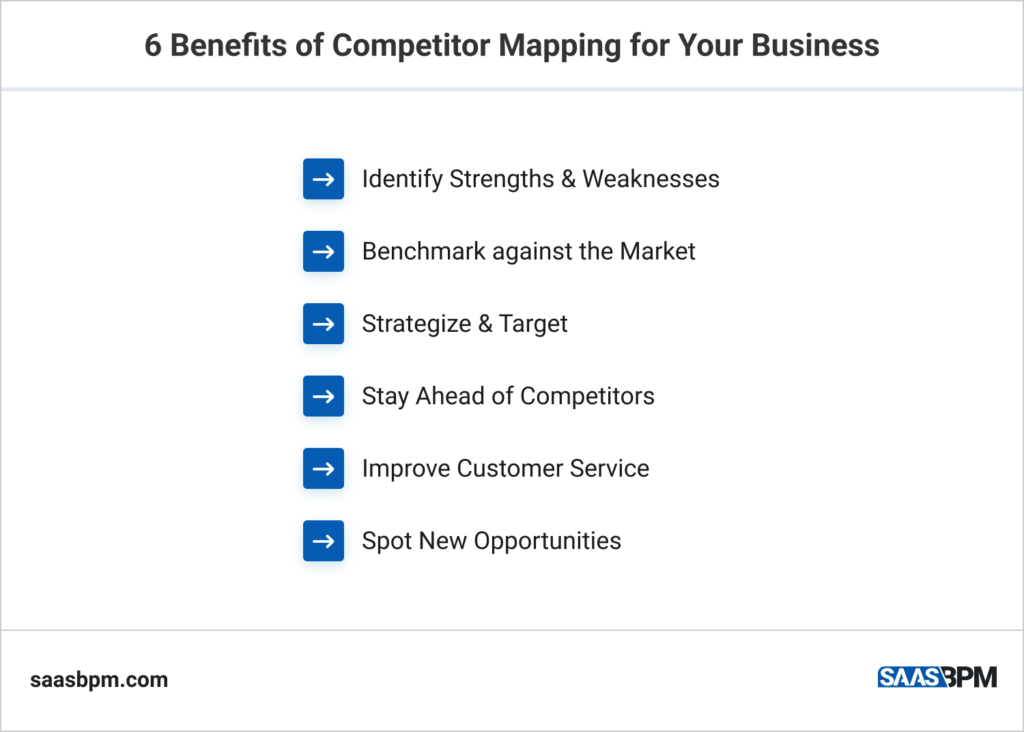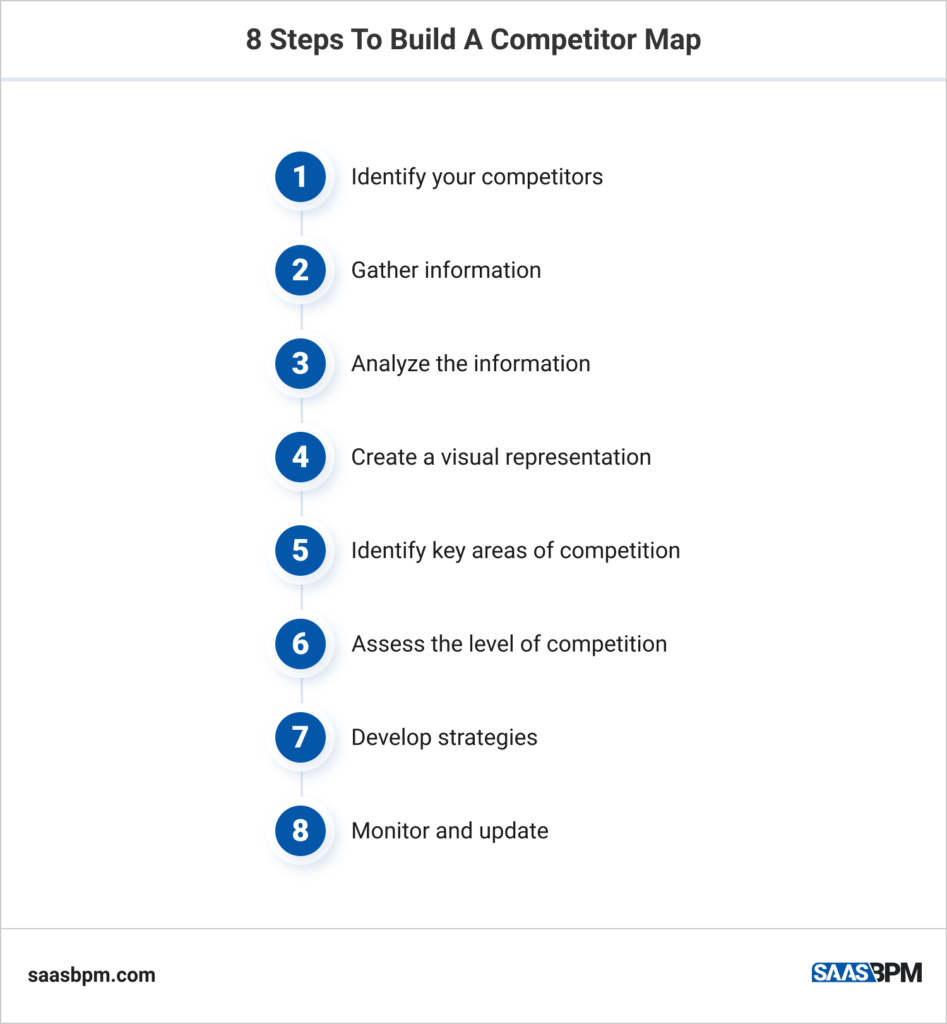Competitor mapping is the process of presenting your competitor analysis insights into graph, charts and other visuals. The aim – make them more concise and easy to assess so you can spot problems in your own business and fix them. More often than not, the relation between two or more metrics remains undetected due to poor resource management. Therefore, it is best to “map out” the data you have attained so it is transparent and easy to monitor.
Especially in times of uncertainty and predictions that 2023 will be tough for marketing and sales, it is important to constantly identify areas for improvement in your business and analyse your performance within the industry.
By building a transparent and comprehensive competitor map, you can spot differences between what you deliver, and your rivals. This way, you will always be on your toes ready to innovate and improve.
In this article, we will first define what competitor mapping is and its benefits for business. Then, we will run you through the necessary steps to build a solid competitor map to improve your performance and grow sales.
What Is Competitor Mapping And Why Does It Matter For Businesses?

Competitor Mapping: Definition
Competitor mapping is the process of identifying and analyzing the strengths, weaknesses, and overall competitive landscape of other companies in your market niche. This includes reviewing their products, services, pricing, marketing strategies, and other factors that may impact their performance.
The goal of competitor mapping is to gain a better understanding of where your business stands. This way, you can build strategies to gain a competitive advantage over rival companies. It can be done through various methodologies like market research, customer feedback and SEO site audit. The key is to identify and analyze your direct competitors and how you can learn from them to improve.
Business Benefits of Competitor Mapping
As you probably already know, competitor mapping is key if you want to your business to be among the top players. Here are the advantages you will gain from doing a regular in-depth analysis of your competitors:

Identifying strengths and weaknesses: By studying your competitors, you can identify the areas where they excel and areas where they are lacking.
Benchmarking: Competitor mapping allows you to benchmark your own performance against that of your competitors, helping you to see where you need to channel more input.
Developing effective strategies: By understanding your competitors, you can develop effective strategies to differentiate your products or services, target new markets, and improve your overall performance.
Staying ahead of the competition: Keeping track of your competitors can help you to stay ahead of the game by anticipating their moves and staying ahead of industry trends.
Improving customer service: By monitoring your competitors’ customer service strategies and processes, you can improve your own customer service offering, making it more efficient and effective.
Identifying new opportunities: Competitor mapping can help you to identify new opportunities in the market that you may not have been aware of before. By understanding your competitors’ products, services, and target markets, you can identify areas where there is a gap in the market and explore ways to fill it.
8 Steps To Build A Competitor Map

1. Identify your competitors
The first step in building a competitor map is to identify who your main competitors are. This can be done through market research, customer feedback, and online research. Market research can help you to identify the key players in the market, while customer feedback can give you insight into how your customers perceive your competitors. Online research, such as reviewing competitors’ websites, social media, and online reviews, can also provide valuable information about your competitors.
2. Gather information
Once you have identified your competitors, you need to gather information about them. This includes their products, services, pricing, marketing strategies, and other relevant information. This information can be obtained through a variety of sources such as company websites, press releases, industry reports, and customer feedback.
3. Analyze the information
After you have gathered information about your competitors, you need to analyze it in order to understand their strengths, weaknesses, and overall competitive position. This could include analyzing their market share, customer base, and brand awareness, as well as their product offerings and pricing strategies.
4. Create a visual representation
Once you have analyzed the information, you need to create a visual representation of the competitor map. This can be done through a matrix, a chart, or a diagram. This visual representation should make it easy to see the main competitors, their key areas of competition, and their relative strengths and weaknesses.
5. Identify key areas of competition
After you have created a visual representation of the competitor map, you need to identify the key areas of competition. This includes the products and services that are most similar, the target markets, and the pricing strategies. Identifying these key areas will help you to understand where the main competition is coming from.
6. Assess the level of competition
Next, you need to assess the level of competition in each key area of competition. This will help you to understand the level of threat that each competitor poses to your business. For example, a direct competitor that has a similar product offering and target market as your business will pose a higher level of competition than a competitor that is in a completely different industry.
7. Develop strategies
After you have assessed the level of competition, you need to develop strategies to address the areas of competition. This can include developing new products and services, targeting new markets, and improving your overall performance. By developing these strategies, you will be able to address the areas of competition and gain a competitive advantage over your competitors.
8. Monitor and update
Finally, you need to monitor your competitors and update your competitor map regularly. This will help you to stay ahead of the competition and make informed decisions about your business. Keeping track of competitors’ activities, pricing strategies, and product offerings will help you to anticipate their moves. This way, you can plan any necessary adjustments to your own marketing plan.
Wrapping Up
Competitor mapping is very important if you are determined to make your business stand out from the competition and level up consistently. We’ve outlined all the main benefits a competitor analysis done well can bring to the table. Also, we described 8 best practices to map out your direct competitors in a comprehensive way. However, it’s up to you to train your team on the business processes involved once you’ve identified the areas of your business that need improvement.

